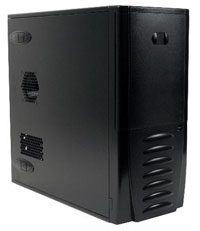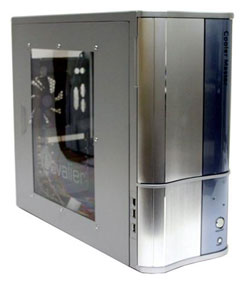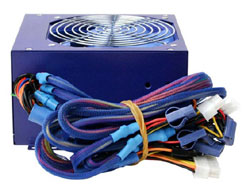Buyer's Guide - Mid-Range, January 2005
by Jarred Walton on January 21, 2005 11:09 AM EST- Posted in
- Guides
Case and Power Recommendations
We've got all the internal components picked out now, so all that's left is the choice of case, monitor, and a few other external parts. Preference for case design can vary wildly from person to person, so if you have a favorite case, you should get that. A lot of us prefer the clean, elegant looking cases as opposed to models that have a lot of bling-bling, so that's what we'll recommend. Besides, those who really like the bling are better off modding their cases for a truly unique look. We also like quiet cases where possible, although silence and high performance are nearly impossible to achieve at the same time. Finally, for most mid-range and above configurations, you really need a decent power supply to ensure maximum stability - and for that matter, a battery backup is also a good idea. You could try to get a case with a decent power supply included - the Antec cases that we frequently recommend are sufficient for the basic setup - but that really limits your choice of case. We prefer to look at all options and just plan on adding a better power supply - and if you're seriously considering the SLI configuration, don't even think about getting by with a cheap PSU!
Case Recommendation
Antec SLK-3000-BPrice: $76 Shipped
If that case looks familiar, we're not surprised. We've recommended the 3700-BQE as well as several other BQE Antec models in many of our recent Guides. They include decent power supplies and have a reasonable price, all things considered. The 3000-B is a newer addition that builds off the 3700, only without a power supply. This is a great starter case, and it is very easy to set up initially as well as upgrade over time.
There are a few minor differences between this model and the 3700. First, it includes a cooling duct that allows the CPU fan to draw in cool air directly from outside. There are ventilation holes on the left side of the case for both the duct as well as lower down over the expansion card area. The case includes a 120 mm temperature controlled fan in the rear - a fan that is very close to silent - and there is room to add another 120 mm fan in front of the hard drive bays. Rather than slots for four hard drives with a tray, there are five hard drive slots. We're not sure if we like the loss of the trays, as they do make it easier to temporarily remove the drives. Overall, though, we like the modifications, even if they're not terribly important in the larger scheme of things. About the only missing feature that some people will want is a front Firewire port.
If you go with the base mid-range configuration that we're recommending in this Guide, you could probably go with the 3700 and get the included 350W PSU for about $20 more, but we recommend the purchase of a more capable power supply. The Antec Sonata is also available for a few dollars more and includes an even better 380W "TruePower" power supply, but it isn't quite as roomy, should you add the second 120 mm fan. For the overclocking/enthusiast configurations, you'll definitely need a better power supply - especially if you actually plan to go for an SLI system during the life of the computer. Our PSU recommendation is below.
Case Alternative
CoolerMaster Cooler Master Cavalier 3, model CAV-T03-WWPrice: $112 Shipped
If you want a case that's a little flashier, we like the CoolerMaster Cavalier. It's available in a couple of different color schemes, with the silver/blue model shown here. It has a case window; front USB, audio, and firewire ports; a rear 120 mm fan; and a steel frame with aluminum front bezel and panels. Expansion options include five 5.25" external bays and four 3.5" bays, one of which is external. All of the bays have a tool-less latching mechanism that works pretty well. The external drive bays are all covered by a door, but there's a catch with this design: the direction that the door opens can be modified. Most doors open to the right, but that doesn't always work for some people, so it's nice to see a case that addresses that concern. Overall, this is a very well constructed case at a reasonable price.
Power Supply Recommendation
Fortron Source Blue Storm 400W, Model FSP400-60THN-RPrice: $59 Shipped
Our choice of power supply comes from Fotron Source, one of the more reliable manufacturers. It has several noteworthy features that put it ahead of competitors. The 120 mm fan helps to reduce the noise levels relative to most 80 mm fans, and it has sheathed cables. Another nice addition is the inclusion of a 24-pin BTX/EPS12V power connector, with a 20-pin ATX power adapter. It's certainly not required for all motherboards, but for the latest Intel models, we prefer to go with a 24-pin connector instead of a 20-pin. It also includes dual 12V rails, which helps to guarantee a sufficient amount of power to components such as hard drives and graphics cards. While 400W may not seem like all that much, we consider this a quality 400W PSU - many lesser brands would rate this as a 500W+ PSU.
Good alternatives from Antec, Enermax, OCZ, Sparkle, Ultra and several others exist, but they all tend to cost a bit more than the Fotron Source PSUs. We've recommended several of these power supplies in past Guides, and the previous recommendations still stand. One item that is missing from this Fotron is the new 6-pin PCIe graphics power connector - two 4-pin molex connectors can be used with an adapter, of course. Some may also find the blue light within the PSU to be a bit distracting, although it's really not so bright that would cause us to worry about it. As an alternative, check out the OCZ ModStream and PowerStream PSUs; they cost a lot, but their warranty and reliability is very good. A more powerful PSU would definitely be recommended for SLI setups.













46 Comments
View All Comments
JarredWalton - Sunday, January 23, 2005 - link
35 - Damn. Foiled. :) I forget these things over time. Wasn't the original Raptor TCQ and the newer version has something like "TCQ-II" which was supposed to improve on standard TCQ somehow? Anyway, our NCQ article didn't really show a major benefit for desktop use, but I've fixed the error now. Thanks!REMF - Saturday, January 22, 2005 - link
"On the other hand, if improved performance is what you're after, the best two choices are either one of the 16MB cache Maxtor drives or the 74GB Western Digital Raptor [RTPE: WD740GD] with its 10,000 RPM design - both of these also offer NCQ, in case you were wondering."the Raptor offers Tagged Command Queuing, not Native Command Queuing.
JarredWalton - Saturday, January 22, 2005 - link
Regarding post #30 and the NEC 3520A, a reader sent me an email informing me that the 3520A uses a new chipset and thus the 3500A is *not* upgradeable to the 3520A via a BIOS flash. Barring any contradicting views, I'll stick with that.JarredWalton - Saturday, January 22, 2005 - link
31 - our RTPE doesn't currently differentiate between the ST3160023AS and the ST3160827AS, unfortunately. For example, the Newegg listing currently priced at $111.50 + $4.69 shipping is the appropriate NCQ model. In reality, the NCQ doesn't seem to be a big deal for non-server systems (just like RAID), but if it's only a few dollars more why not get it? That was my feeling. There are even a couple listings in the RTPE for the ST3160021AS. Basically, the RTPE bots match items according to size and features, but NCQ doesn't seem to be something they're aware of yet.kamaboko - Saturday, January 22, 2005 - link
you know the saying, "can't please all of the people all of the time". i think that applies here. in any case, i found this guide useful since i'm looking at a near total ground up rebuild--minus dvd burner, audigy 2zs, and monitor.beakerman - Saturday, January 22, 2005 - link
"With the added benefit of Native Command Queuing (NCQ), the Seagate drives continue to impress. The Seagate 160 GB SATA [RTPE: ST3160023AS]"According to Seagate, the ST3160023AS does not feature NCQ. I believe the drive you want is the ST3160827AS, which is actually a few $$ cheaper. Both drives are 160 GB SATA.
JarredWalton - Saturday, January 22, 2005 - link
26 - Sorry, I got the wrong "updated burn speeds" in there. The 3500A is indeed capable of 16X DVD+/-R recording. The difference is that the 3520A can do DVD+RW at 8X and DVD-RW at 6X, while the 3500A is stuck at 4X for both. There's a reasonable chance, of course, that a BIOS flash of the 3500A can turn it into the 3520A. I updated the text with this information.28 - The "alternative" was meant as a closer to high-end option. 50% more for the CPU for 10% more performance is a rather expensive upgrade. The jump to the 3800+ is even worse, coming in at 100% more than the 3500+ for a 9% performance increase. I've updated the text slightly to make this more clear. For overclockers, I definitely wouldn't bother with the added cost of the 3500+.
27 - I did mention the home theater aspect for the speakers (last part of the 5300e paragraph), but we're certainly not going to spec out an entire home audio setup, so there's not much to do other than mention it. Your comment ties into the next point:
29 - 2.1 speakers aren't much cheaper than the 5.1s, and you can always just leave the rear speakers disconnected. Still, you have a point that some people really don't want more speakers. In that case, I'm not sure why they would bother with anything more than 2.0 speakers, though. There *are* great 2.0 and 2.1 speakers out there, but then you're almost better off looking at the home audio equipment instead of PC speakers. I dunno... I suppose the Swans are always an option. Anywat, I modified the text to include 2.0/2.1 speakers and headphones as something to consider, along with home theater audio. I moved this into a separate paragraph to draw more attention to it.
Dranzerk - Saturday, January 22, 2005 - link
One suggestion for next buyers guide, I think all kinds system setups like 2.1 speaker systems, you should offer a 5.1 and 2.1 for each type instead of just 5.1.I know some personally don't like 5.1 sounding speakers, and prefer 2.1 speakers.
The logitech Z3 2.1 fit that bill perfectly, you can find them for under $50 also, and they get great reviews.
Pjotr - Saturday, January 22, 2005 - link
I think you are fooling buyers into a wrongful purchase when it comes to performance. In the AMD "Upgraded" PCIe Athlon 64 System you have gone from 3200+ for $215 to 3500+ for $334. The performance increase from 2.0 to 2.2 GHz is smaller than 10 %, in many applications like games it might even be close to 0.Instead of adding $119 for this 0-10 % performance gain, I think sticking with the 3200+ CPU and changing the graphics card from 6600GT to 6800GT (Leadtek A400) is a MUCH better choise, It will cost you £377 minus $190 = $187. If you want to come down close to the $119 difference don't get an SLI motherboard.
This graphics upgrade will make wonders in anything graphics related compared to a 10 % CPU clock speed upgrade that is seldom noticed in anything.
Caligynemania - Saturday, January 22, 2005 - link
Great article, just one comment. With your reccomendation of speakers and sound card as alternatives, you really should mention that a receiver/speaker combination would probably be most people's best bets. A good receiver will run slightly more than the sound cards you mentioned, but the selection for real speakers is infinitely better than computer speakers.